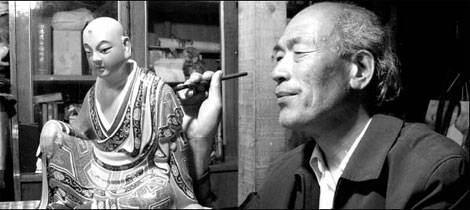|
|

Bo Ziyang adds color to one of his clay figures. Over the past 50 years, he has made sculptures out of clay collected from the Yellow River. Zhan Ruiwan / China Daily |
An elderly man holding a chunk of clay and a chisel is concentrating hard in his 20-square-meter workshop. A character from the Outlaws of the Marsh, one of the four most famous classical works of Chinese literature, slowly begins to take shape.
Bo Ziyang, 68, of Jinan, Shandong province, has spent the past 50 years making sculptures out of clay collected from the Yellow River.
Before starting a piece of work, he always finds representative photos of the characters he sculpts, reads about them and then chooses the appropriate clay.
"All of the clay sculptures I have created are made of Yellow River clay. The river that has given birth to the Chinese is also my creative source," Bo says.
But it is not easy to find Yellow River clay suited to sculpting. Only clay that is highly sticky and contains no sand can be used. For the past 50 years, Bo's quest for the right clay has seen him going to the river bank religiously every week.
"The moment I find satisfactory clay is my happiest moment. The clay gives soul to the sculptures," Bo says.
Once the clay is chosen, the next steps involve its shaping, polishing and airing, before the adding of color.
This calls for particular care, as the process requires great patience and perseverance.
"Adding color contributes 70 percent to a good clay sculpture," Bo says.
His hands have so far shaped figures from A Dream of Red Mansions, The Outlaws of the Marsh and prominent figures from Chinese history.
In 1997, when Hong Kong returned to the motherland, Bo came up with clay sculptures of 88 Chinese celebrities including late Chairman Mao Zedong and Deng Xiaoping.
Bo spent three months, putting in at least 15 hours every day, making these sculptures. "Nothing makes me more happy than shaping clay," Bo says.
Many of his sculptures can be seen at most parks in Jinan including Daming Lake and Qianfo Mountain.
He developed an early interest in clay sculpture and went on to acquire professional skills at the Jinan Sculpture School when he was 17.
Bo perfected his art under Wang Zhaoshan who was known for his knowledge of Western sculpting styles.
He still clearly recalls the difficult 1960s when China found itself in the grip of a severe famine.
"Several times I fell faint with hunger, with the unfinished clay still in my hands," Bo recalls.
After the economy's opening-up, all of his classmates gave up sculpting finding that it didn't make any money. But Bo continued.
Zheng Yubin, head of the Huaxia Cultural Promotion Association, says: "Bo's sculpting is sophisticated and his works show his love for it."
A clay sculpture exhibition will be held in September to celebrate his 50 years in this filed.
Bo says he will formally retire after this exhibition. "I will donate all of my works to the Jinan and Rizhao museums," he says.
By Zhao Ruixue and Zhan Ruiwan
(China Daily 06/22/2010 page20) |